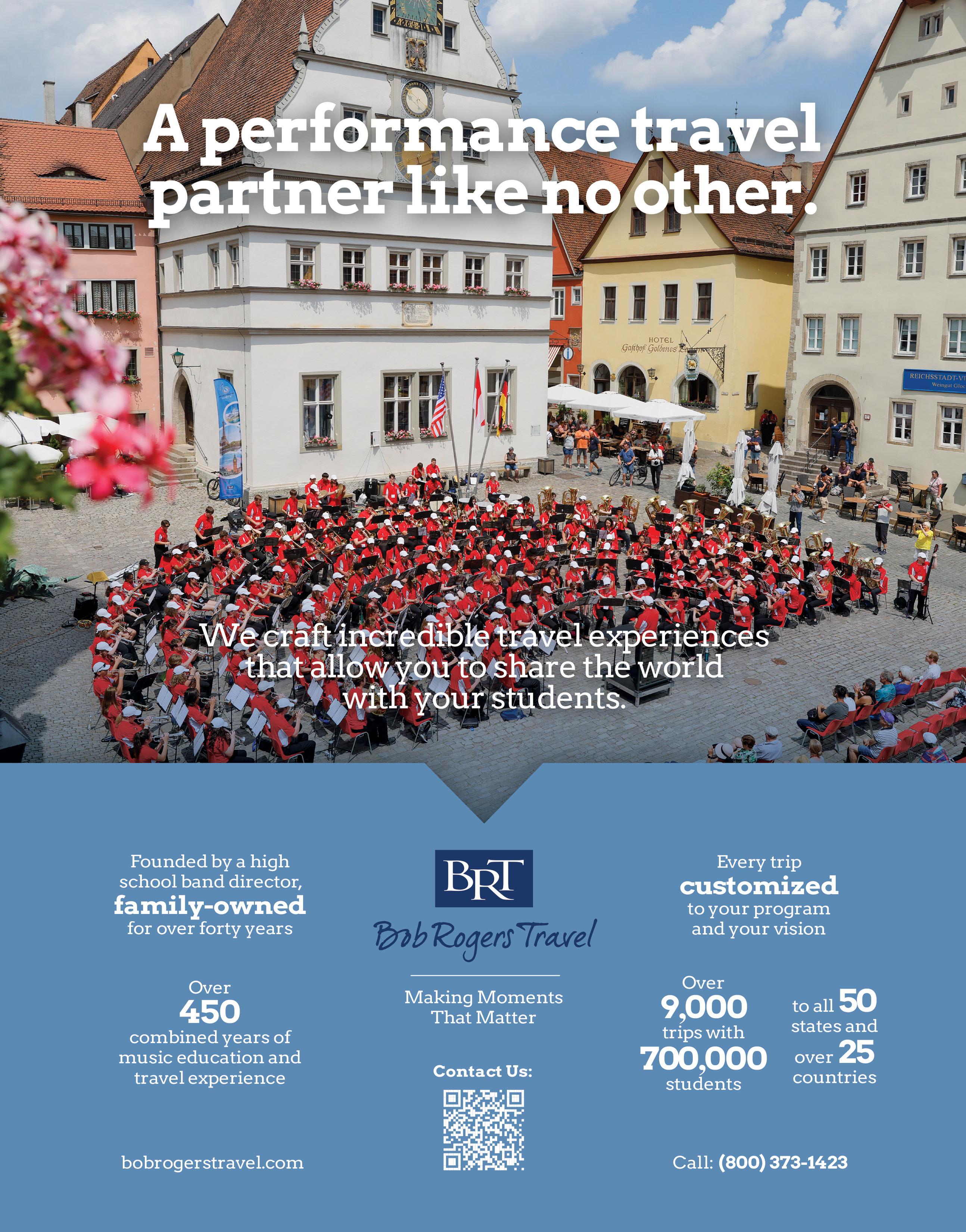

GEORGIA:
FROM SKYLINES TO SHORELINES

THE COVER
I'm sure somewhere in Missouri. Photo © Whoever took the picture.

PUBLISHER OF TEACH & TRAVEL
SERENDIPITY MEDIA, LLC
www.serendipity-media.com | (866) 252-7108
THE TEAM
KASIE SMITH, President & Publisher
COURTNEY VAN HAGEN, Art Director
CLAIRE CHAPIN, Graphic Designer
JOSH VEAL, Editorial Manager
HANNAH HOHMAN, Marketing Coordinator
MEGAN MARSHALL, Accounting & Operations Specialist
MAGGIE MUTCH, Communications & Event Coordinator
YOUR MEDIA CONSULTANTS
(866) 252-7108
KARY MOENING, kary@serendipity-media.com | x109
HALEIGH GERWIG, haleigh@serendipity-media.com | x117
MEMBERS OF:
AMERICAN BUS ASSOCIATION
CIRCLE MICHIGAN
NATIONAL TRAVEL ASSOCIATION
ONTARIO MOTOR COACH ASSOCIATION
STUDENT & YOUTH TRAVEL ASSOCIATION
SUBSCRIPTION INFORMATION
Teach & Travel – The Official Publication of SYTA may be obtained by filling out the subscription card or calling 866-252-7108. Subscribe online at https://hello.teachtravel.org/teach-travel-subscribe. Teach & Travel is published bimonthly by Serendipity Media, LLC; 519 Ada Dr. SE, Ste 201, Ada, MI 49301. Subscription information may be obtained through the above address, by calling 866-252-7108, or by logging on to www.teachtravel.org.
POSTMASTER: Send address changes to Teach & Travel c/o Serendipity Media, LLC; 519 Ada Dr. SE, Ste 201, Ada, MI 49301.
All rights reserved. Teach & Travel content may not be photocopied or reproduced or redistributed without the consent of the publisher.
DEPARTMENTS
Traveling Teacher of the Year: Cherie Garrett
Hotel Safety Checklist
COVER Photo © Visit Savannah

BRENT IMRIE President, SYTA
Managing Director, Tour Time
inspiresport New Zealand and Australia
Kia ora and warm greetings, As the newly appointed President of SYTA, it is an honour to welcome you to this edition of Teach & Travel
KHaving just returned from our Annual Conference in beautiful Savannah, Georgia, I am energised by the passion, connection, and commitment shared by our incredible community. It is a powerful reminder of why we do what we do—bringing meaningful, lifechanging travel experiences to students.
I step into this role with deep gratitude and a truly international lens. As a long-time tour operator based in Australasia, I have seen firsthand the global impact of student travel and the importance of cross-cultural learning. My goal is to ensure SYTA continues to lead the way—not just in North America, but globally—in promoting safe, educational, and transformative travel experiences for all young people. Together, we are creating moments that inspire, empower, and stay with them forever.
In this first issue of the schoolyear, we’re excited to dive back into student travel. This month, we’re taking a look at Georgia as our U.S. destination, exploring the Peach State’s beautiful nature and long history, going back to the days of 13 colonies. Then we head north to the freshwater Great Lakes area for the North American destination, and explore the rich and diverse culture of Portugal for our international trip.
Most exciting for this issue, perhaps, is our announcement of the second-ever Traveling Teacher of the Year. There are so many incredible educators who go above and beyond to make travel possible for their students, no matter the barriers, they deserve to be celebrated. After receiving quite a few excellent nominations, we narrowed it down to eight finalists, and then passed it on to voters to decide.










Ultimately, our second recipient of the Traveling Teacher of the Year is Cherie Garrett, a Spanish teacher at Dallastown Area High School in York County, Pennsylvania. She has been teaching Spanish for the past 30 years, taking students on trips to Peru, Madrid and other Spanish-speaking destinations. She’s also the coordinator of the Intermediate World Language Program and the World Language Career Symposium, the advisor of the Global Scholars Program, a proctor of the National Spanish Exam and a frequent presenter at world language conferences. Check out our interview with her to learn more!
Of course, this issue also has tips and resources for educators, from discussing hotel and hostel safety to managing uncertainty and fundraising effectively. Not to mention the winning piece from this year’s World Is A Classroom student essay contest.
With student travel back in a big way (as evidenced by the recently released 2024 Student Travel Business Barometer), it’s an exciting time for everyone involved.
Thank you for being part of this vibrant and purpose-driven community. Whether you are planning student travel across town or across the globe, SYTA stands with you as a trusted partner, advocate, and resource.
I am excited for what lies ahead and look forward to working with all of you to expand the reach and impact of student travel— locally, nationally, and internationally. Together, we will continue to open minds, broaden horizons, and create moments that truly matter in the lives of young travellers.
Ngā mihi nui!










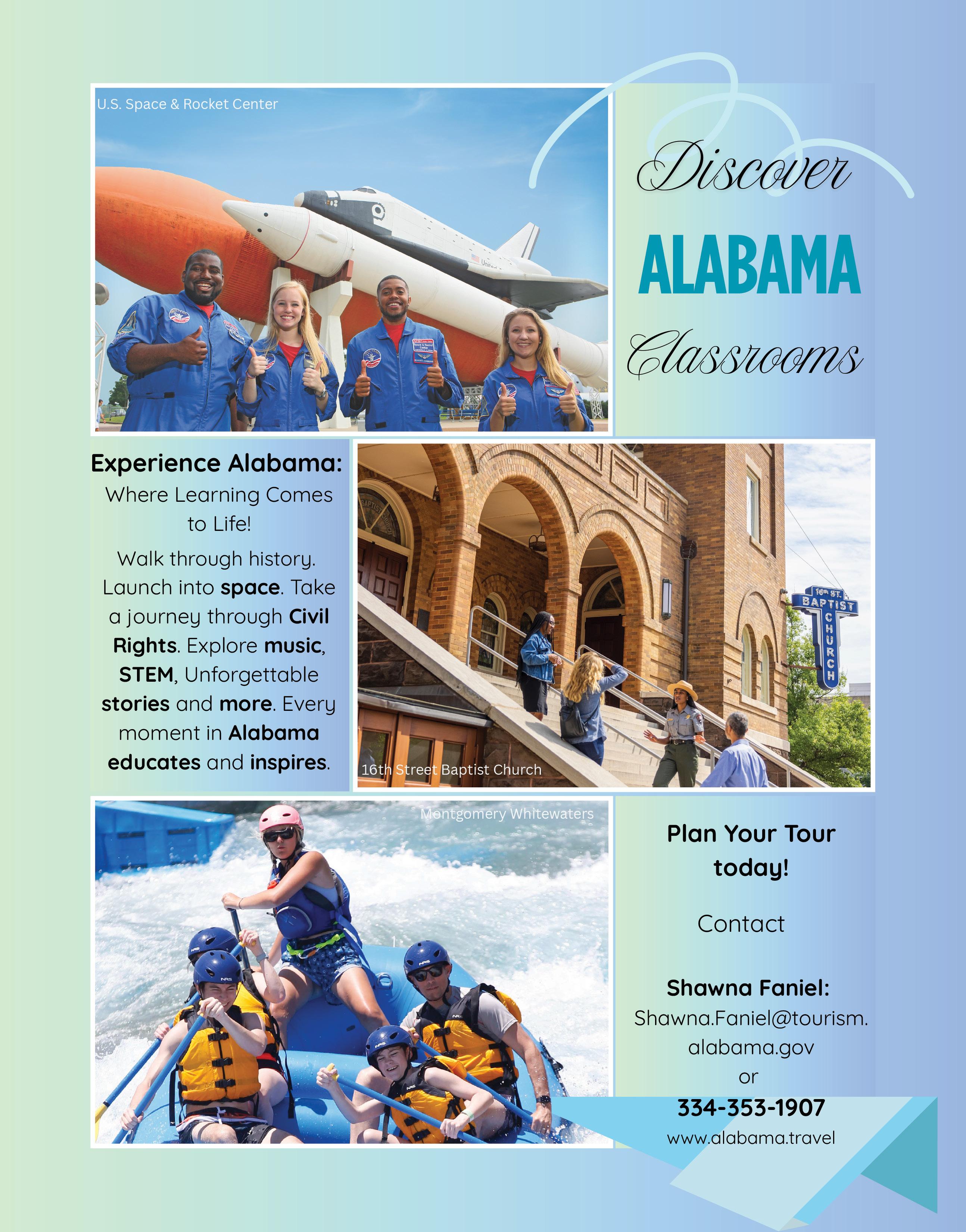
SYTA Youth Foundation ROAD SCHOLARSHIP
The SYTA Youth Foundation (SYF) established the Road Scholarship program in 2002 to award funds to youth who are unable to afford the cost of student group trips. Based on the belief that travel is essential for a complete education, it is SYF’s goal to make a positive difference, through travel, in the young lives of our global citizens. Since its inception, SYF has impacted more than 7,200 students. A Road Scholarship is financial aid granted to individuals or groups of five or more who have been nominated by a teacher or youth group leader and who meet criteria within five categories:
APPLICATION PERIOD:
TRIPS MARCH 2026 – AUGUST 2026
Application Opens September 22, 2025
Application Closes November 7, 2025
Announced the week of December 1, 2025
WHO CAN APPLY? Students in grades K-12 and 18 or younger at the time of travel will be considered. Nominations must be submitted by an educator, program leader or designated school official, Nominations submitted by parents or guardians will not be considered.
TRIPS AUGUST 2026 – FEBRUARY 2027
Application Opens January 26, 2026
Application Closes March 27, 2026
Announced the week of April 20, 2026
HOW MUCH IS AWARDED? Up to $1,000 USD will be awarded to an individual and a maximum of $5,000 USD will be awarded to a group nomination. Nominations requesting an award higher than the maximum will not be considered.
The grants are vetted and approved through the SYF Board of Trustees.
FOR MORE INFORMATION, PLEASE VISIT: https://sytayouthfoundation.org/road-scholarship Questions, email info@sytayouthfoundation.org



SAVANNAH SAMPLER
From green squares to salty air, Savannah is a dynamic way to learn beyond the classroom. Start with a walking or trolley tour to take in Savannah’s rich past. Visit the Massie Heritage Center for a look into 19th-century school life. Enjoy a boxed lunch in one of the city’s charming squares, then stroll Broughton Street for honey, pralines and Leopold’s Ice Cream. Tour the National Museum of the Mighty Eighth Air Force, then end the day with a thrilling ghost tour. Explore the Georgia State Railroad Museum , then visit historic homes like the Owens-Thomas House and Juliette Gordon Low Birthplace. Learn to dance the Charleston at the American Prohibition Museum , dine with legends at The Pirates’ House and catch a Broadway-style show at the Savannah Theatre Walk the trails at Oatland Island Wildlife Center, have lunch at The Crab Shack , and dive into marine life on a Tybee Beach Ecology Trip. End with panoramic views from the Tybee Island Light Station Learn more at visitsavannah.com.
WHERE INNOVATION MOVES
On September 20, 2025, downtown Lowell bursts to life during the Lowell Kinetic Sculpture Race—a one-of-a-kind event where humanpowered sculptures race across streets, sand, and water in a dazzling display of engineering and imagination. It’s a kinetic celebration of STEAM learning, creativity, and community spirit that turns the city into an open-air classroom.
Located in Massachusetts’ Greater Merrimack Valley—now known as Revolutionary Valley—Lowell is a city where revolutions never stopped. From the Industrial Revolution to ongoing cultural and artistic movements, the city offers rich educational opportunities for student and group travel.
Explore the historic mills and canals that powered a nation, walk in the footsteps of innovators, or immerse your group in art, music, and multicultural tours throughout the city. Whether you teach history, science, or the power of invention, Lowell invites you to experience a region where learning truly moves. Discover Revolutionary Valley at revolutionaryvalley.org.
Photo © Visit Savannah
TASTE OF HISTORY
Come see what’s new at World of Coca-Cola! Always a hit with student groups, World of CocaCola invites students to learn the story behind the iconic beverage brand through immersive exhibits and exclusive beverage tastings, including two new experiences: Coca-Cola Stories and Icons.
In Coca-Cola Stories, students will be immersed in the brand’s history through unique artifacts and historically inspired environments. Relive key moments in Coca-Cola’s legacy, complete with photo opportunities like appearing in a vintage Coca-Cola ad or posing with a 1939 delivery truck.
Another highlight is Icons, a celebration of the icons that shaped Coca-Cola into a global brand. Students can explore historic items, including the original Coca-Cola script, the iconic Contour bottle, the Polar Bear, Santa Claus, and famous taglines.
No visit is complete without savoring the flavors of Coca-Cola from around the globe, offering a refreshing and engaging experience for everyone.
To book your visit, call Group Sales at 404-676-6074 or email WOCCGroups@coca-cola.com!
MURDERS & MERRIMENT
Shear Madness is one of the most popular productions in the world, delighting audiences’ night after night with its unique blend of madcap improvisation and spinetickling mystery.
This unique comedy whodunit takes place today in the Shear Madness hairstyling salon in whatever city where it plays. It is chock full of up to the minute spontaneous humor and local references. During the course of the
action, a murder is committed and the audiences gets to spot the clues, question the suspects and catch the killer, amidst much merriment.
Voted Best Comedy of the Year seven times by the Boston Globe and recipient of Best Play of the Year by both the Chicago Sun-Times and the Philadelphia Enquirer, Shear Madness has also received the Raven Award from the Mystery Writers of America and has been inducted into the Comedy Hall of Fame, the first play ever to receive that accolade.
Learn more at shearmadness.com
HIGHER EDUCATION
The Empire State Building Observatory Experience—voted the #1 attraction in the world by Tripadvisor travelers—features an interactive museum with nine galleries and offers unmatched views from its iconic 86th and 102nd Floor Observatories.
The reimagined Observatory Experience provides complimentary interactive lesson plans for student group visits to the building, in partnership with Bank Street College of Education. The curriculum follows New York State Learning Standards for STEAM and social studies, and features grade-appropriate learning plans and enrichment activities for elementary, middle, and high school students. Groups can continue to learn after their visit with ESB’s online education center.
ESB invites approved choir groups of up to 60 members for iconic performances at the Observatory’s Grand Staircase, with an electric piano and music stand provided. Choir members will enjoy access to the immersive museum and 86th Floor Observatory included in their tickets.
The Empire State Building Sales
team provides tailored experiences for groups of all sizes and interests. Work with them at esbnyc.com.
LEVEL UP LEARNING
With locations all across the United States, Main Event offers a unique blend of educational and entertainment experiences tailored to enrich students’ learning while ensuring they have fun.
At the heart of Main Event’s educational offerings is the Play Academy, an accredited STEAM curriculum developed in collaboration with Big Thought and STEM.org. This program integrates real lessons with interactive games, demonstrating that the more students play, the better they learn.
The Play Academy features various labs, including How To: Bowl Like a Boss, Up Your Game With Science, Blast Your Friends With Bouncing Beams, & Get a Fair Piece of the Pie. Each lab lasts approximately one hour and is facilitated by a Main Event staff member, ensuring a structured and engaging learning environment.
Learn more about group packages at mainevent.com.
NEW BEGINNINGS
As a premier travel destination, Branson is raising the bar this year with a lineup of thrilling new attractions and convenient lodging. The new Truth Traveler combines 5D virtual reality, haptics, and immersive sound to transport guests on an unforgettable journey through the Bible. Also new this season is Fear Not, a live theatrical experience that pulls audiences back to the dramatic days of Herod the Great’s reign.
The Masters of Escape continues to redefine the concept
of escape rooms, delivering engaging interactive puzzles. Their 1,800-square-foot virtual reality arena transports players to a different dimension where they can be the hero fighting against a zombie horde or parasitic AI drones. The newest addition, Papa Smurf’s Magical Lab, merges a private magic show and interactive tabletop

gameplay with a whimsical twist.
Adventure Seekers, formerly Beyond the Lens, houses over 150 interactive exhibits, virtual reality rides and arcade games, including FlyRide, a thrilling sensory adventure that uses wind, scents, and motion to simulate an aerial tour of some of America’s most scenic locations.
For those seeking comfort close to the action, the new Element by Westin
hotel is set to open by year’s end, providing modern, upscale lodging in a prime Branson location. Fans of Silver Dollar City theme park can also look forward to the brand-new Silver Dollar City Resort, which is scheduled to open in late 2026, and will allow guests to stay immersed in the 1880s charm that makes the park unique.
Start planning with explorebranson.com.

CENTER STAGE
Broadway is the quintessential live experience for students, and Group Sales Box Office at Broadway.com can help you choose the right show for your group.
2025’s Best New Musical Tony winner, Maybe Happy Ending, tells the deeply human story of a chance encounter that sparks connection, adventure, and maybe even love. The Observer said it’s “the best, most original, most beautiful musical in eons!”
Step into the heart of Cuba with Buena Vista Social Club. Inspired by true events, the new Broadway musical brings the GRAMMY® Award-winning album to thrilling life with a world-class band and sensational cast—a tale of big dreams, second chances, and the unbreakable bonds of making music together.
Stranger Things: The First Shadow welcomes you to the Upside Down. London’s hit show is also 2025’s most Tony-winning play. Entertainment Weekly calls it a “jaw-dropping, must-see theatrical marvel.” Don’t miss this gripping standalone adventure, where suspense and spectacle lurk at every turn.
With acclaimed Broadway Classroom experiences making their return, your group can enhance their trip with in-person educational workshops as well as VIP meet-and-greets with cast members.
To speak with agents, call 1-800-BROADWAY x2 or visit online at groups.broadway.com and submit your requests.
Photo © Matthew Murphy




BY JOSH VEAL
FUNDING
THE JOURNEY: SMART STRATEGIES FOR STUDENT TRAVEL FUNDRAISING

FFor many students, the biggest hurdle to travel isn’t time—it’s money. From airfare and accommodations to meals and admission fees, the costs add up quickly. While teachers can help by traveling in the off-season or choosing more affordable destinations, fundraising remains a critical step in making educational travel accessible to all.
The good news? There’s no shortage of creative and effective ways to raise the funds needed to turn a dream trip into a reality.
START EARLY AND PLAN AHEAD
One of the most important keys to successful fundraising is starting early. Many schools begin planning a year or two in advance to give students and families plenty of time to prepare financially. Clear communication is crucial: Outline the total trip cost, fundraising goals, payment deadlines, and any scholarship opportunities well in advance. Payment plans can also help make the trip more manageable for families.
COMMUNITY CONNECTION
Your greatest asset might be right in your own backyard. Community engagement is a powerful way to raise funds while building support for your program. Reach out to local businesses for sponsorships, donations, or fundraising nights where the band gets a profit share. Highlight the value of student travel by sharing photos and testimonials from previous trips. Consider
offering recognition to sponsors through website mentions, social media shoutouts, or event signage.
Local events are another great avenue. From car washes and bake sales to pasta dinners and talent shows, these gatherings offer opportunities to raise money and foster school spirit. Hosting raffles, silent auctions, or vintage markets—where families donate gently used items for resale— can also bring in revenue.
Don’t overlook service-based fundraisers either. Students can help at community festivals, rake leaves, shovel snow, or assist with local cleanups in exchange for donations toward their trip.
TRIED-AND-TRUE PRODUCT SALES
Selling tangible goods remains one of the most dependable ways to raise funds. The trick is making sure you’re offering something that’s useful to a large variety of people; rarely do folks want a knickknack that doesn’t serve a purpose.
Common popular items include sweets like candy or chocolate, food items like pizza kits or popcorn, seasonal gifts like poinsettias or wreaths, home goods like candles, and even handmade crafts made by the students themselves.
GO DIGITAL: ONLINE FUNDRAISING PLATFORMS
In today’s world, online fundraising is not only convenient— it’s expected. Several platforms are designed with educators and student groups in mind:
» SimpleRaise: Built by former educators, this platform equips you with intuitive tools to manage and track your fundraising efforts so you can stay focused on teaching, coaching, and advocating. There are no fees, and you keep 100% of the donations.
» DonorsChoose.org: Especially useful for funding classroom projects and travel-related experiences, this teacherfounded site lets donors directly support your request. Projects stay live for up to four months and have a high success rate.
» Fundly: This mobile-friendly app makes it easy to launch a campaign, update supporters, and thank donors. There are no minimums to withdraw funds, but a platform and processing fee applies.
» FundMyTravel: Tailored specifically for travel, this platform helps you budget, incentivize donors, and track both online and offline contributions. There’s a 5% platform fee, plus standard payment processing charges.
Whichever platform you choose, make sure to keep your supporters informed and engaged with updates, photos, and progress reports.
SCHOLARSHIPS MATTER
In addition to fundraising, remember that scholarships can play an important role. Programs like the SYTA Youth Foundation’s Road Scholarship provide financial assistance to students and groups who might not otherwise be able to participate. Visit sytayouthfoundation.org for application details.







I2025 TRAVELING TEACHER OF THE YEAR
CHERIE GARRETT
BY ALLISON KAY BANNISTER
In 2024, Teach & Travel introduced its Traveling Teacher of the Year award to honor educators who take their students and their studies outside of the classroom and into the world. Teachers who embrace the daunting yet rewarding task of leading educational trips provide students not only with memories that last a lifetime, but with experiences that expand their horizons, teach them cultural awareness, and challenge them in ways that inspire growth and build confidence.
Now in its second year, this award continues to put the spotlight on these extraordinary teachers. For 2025, we received numerous nominations and selected eight finalists. The public voted, and Cherie Garrett at Dallastown Area High School in York County, Pennsylvania, was our winner!
Cherie has been a high school Spanish teacher for 35 years, starting at Bermudian Springs High School in Adams County, Pennsylvania, where she taught for eight years. While there, she was offered an opportunity to return to the home school district where she graduated from—and she seized it. She’s been at Dallastown ever since.
Cherie didn’t know she was going to go into teaching. In fact, she didn’t think she wanted to. But, she developed an interest in the Spanish language at a young age. Growing up, her family lived next to a farm and, at age 12, Cherie took a summer job there picking strawberries and blueberries. Working alongside Mexican and Cuban migrant workers who didn’t speak any English ignited her curiosity and she began studying Spanish.
By sophomore year in college at Indiana University of Pennsylvania (IUP), Cherie had become well-versed, and traveled abroad to Spain. When she returned, her advisors asked her if she would be a tutor at the IUP Learning Center and she agreed. “I absolutely loved it from the first night,” Cherie says. “I just was so excited to see the lightbulb go off. And I immediately switched to being a Spanish education major.”
Post graduation and in her first year teaching at Bermudian Springs, Cherie jumped right into creating a student travel program. After attending a language conference, talking with different tour companies, and looking at itineraries, she chose a 15-day trip to Spain. Between both schools, Cherie has facilitated 15 trips abroad with her Spanish language students, going every other year to alternate with other language programs. Participation in the trips is high, with an average of about 25 students, but she’s been at the helm of larger groups, too, including a 56-person trip to Panama and, recently, an 84-person trip to Spain, both of which included parents and chaperones.
It seems pretty remarkable to have so much interest and support, but Cherie says it hasn’t been difficult to convince school administration and parents of the benefits of student travel.
“I pride myself on creating value in the trip at the initial parent meeting,” she says. “I include every detail of the trip, with plenty of photos to build value. But I also explain the impact that it’s had on past students; how studying abroad or
living abroad makes students more marketable in finding employment.” And parents are thankful for that, as are the students. It often sparks a lifelong interest in travel and sets students on a path to greater global understanding.
The trips also keep the students engaged in the curriculum and provide an incentive to stay in the language program, because they’re only offered when a student is in their third, fourth, or fifth year of studies. So, the advantages are myriad.
“It’s really a life-changing experience,” Cherie says. “Many of the students who go on these trips would have never even thought about traveling outside the US, or studying abroad in college, or moving to another country to live. It really opens their eyes and it gets them motivated to get out there and see the world.”

THAT FIRST TRIP IS NERVE WRACKING, but after that, once you get your feet wet, it just gets easier and easier.
In addition, these trips encourage students to stretch outside of their comfort zones—especially those that include activities like ziplining or whitewater rafting. Cherie notes how rewarding it is to see kids face their fears and take on new challenges. In one trip, for example, a student became stranded halfway across a zipline and the only way for her to get to the platform was to pull herself hand-over-hand. “All of the students rallied and cheered her on even though she kept saying that she couldn’t do it,” Cherie says. “When she finally made it to the platform, she was exhausted, but beaming. I can guarantee she learned that she can do anything she puts her mind to!”

Other teachers reading about these adventures might feel a mix of intrigue and apprehension. They might wonder how to start or how to overcome concerns about embarking on such a formidable endeavor. Cherie recommends reaching out to student travel companies to learn about the destinations and itineraries they have available. Many of these companies offer teacher trips for those just getting started, which are a great way to learn how they operate, see what kind of assistance they provide, and gain some peace of mind in taking the initial step. “The more you travel, the more comfortable you get,” Cherie says. “That first trip is nerve wracking, but after that, once you get your feet wet, it just gets easier and easier.”
Cherie’s initiatives, though all interconnected, reach well beyond student travel. It’s one of the reasons she rose to the top to become 2025’s Traveling Teacher of the Year. She’s created or been an integral player in a number of programs in her district and in Pennsylvania.
The first is the Intermediate World Language Program, which she developed in response to a colleague who was looking for ways to challenge a gifted student. Cherie knew this would be the perfect program for this student. It also addresses the current shortage of teachers—especially world language teachers—by encouraging students to try teaching and decide if it’s right for them.
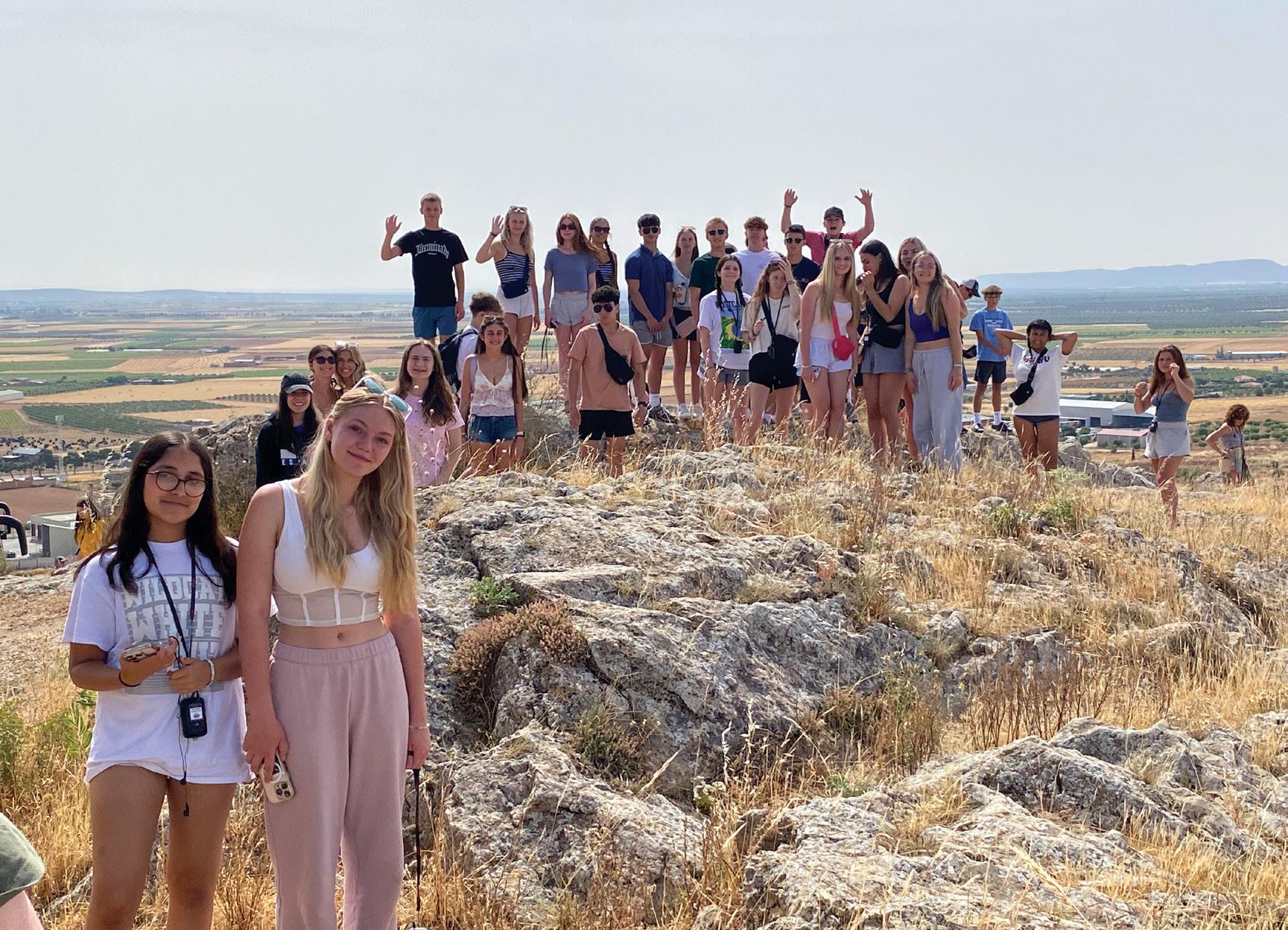
With this undertaking, she teaches high schoolers who are proficient in a second language or are native speakers how to teach. They practice a lesson, and for 10 different weeks in a row, they teach fourth, fifth, and sixth graders. “A lot of those students go on to become teachers, and some of them have become world language teachers because they just love the program,” Cherie says. “And many of the elementary school kids in that program continue taking language in high school. So it’s a win-win for both.”
She also started the World Language Career Symposium, which is now in its tenth year. During this conference, community members, travel companies, student exchange companies, and colleges come in and speak to students about the link between language and careers in business, the medical field, the military, the arts, communications, and politics. It’s offered to the entire high school, and she also invites other the schools in the county, and they bus the students in for the day.
While it started small, it’s grown bigger and bigger every year. This past year, 45 people spoke on 15 different career pathways. “With this conference, I get a lot of kids interested in study abroad programs,” Cherie says. “So I do bring in the three major ones in the area to talk to kids about studying abroad, whether it’s for a semester, the summer, or a full year of high school. That really gets kids excited and thinking about travel too.”

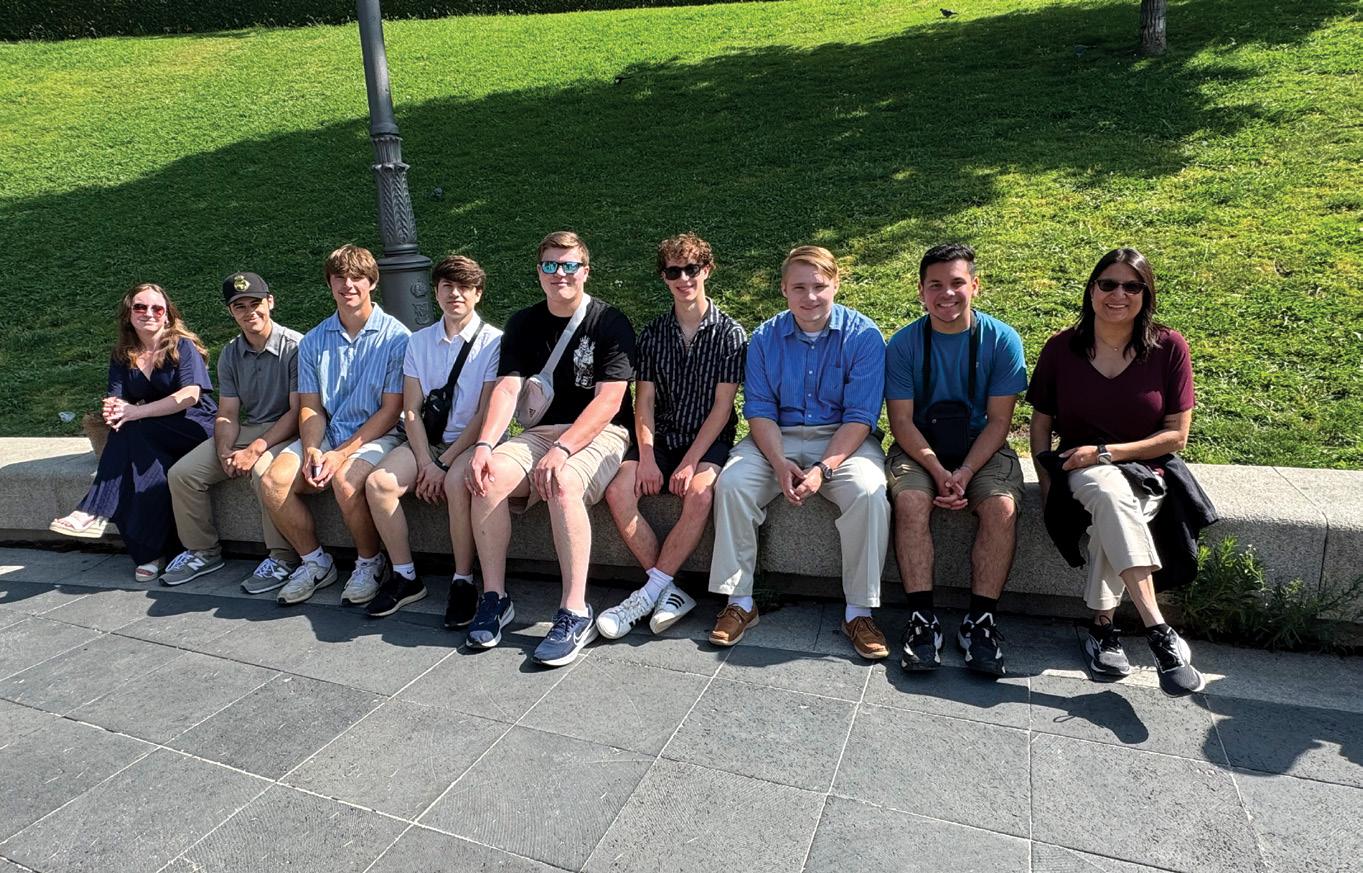
MY STUDENTS LEARN A SKILL THAT CAN BE USED IN THE WORKPLACE AND IT ALSO MAKES THEM BENEFICIAL TO HELPING OTHERS. Having aptitude in another language just gives them one more tool that they can apply in life.

In 2019, Cherie, who is chair of the World Language Department at Dallastown and a member of the Executive Council of Pennsylvania State Modern Language Association (PSMLA), launched the Pennsylvania Seal of Biliteracy for her school. Students who are proficient in English and a second language upon high school graduation earn a credential, and colleges can use that as an evaluating factor for admission. After college, prospective employers can also see their proficiency level.
“It was passed by the state in 2022, and, in fact, they came to my school to announce it, because I was so heavily involved,” Cherie says. “The Pennsylvania Department of Education now recognizes the Pennsylvania Seal of Biliteracy, and it’s definitely a program that is growing.”
And, there’s more! Cherie is also an advisor of the Global Scholars Program, which seeks to create well-rounded, internationally minded, and culturally aware students upon high school graduation. To be involved, students must take at least four years of a language and four credits of other courses that are global in nature. They hold meetings and host events, including a multicultural night that highlights the diversity of the Dallastown district. It’s open to the community, and attracts an array of guests who are interested in learning about the ethnology of their neighbors.
Collectively, her efforts have had a tremendous impact, yet being an educator remains at the heart of everything Cherie does. “It’s extremely gratifying to teach students a second language,” Cherie says. “And teaching combines my passion for Spanish and methodology teaching. My students learn a skill that can be used in the workplace and it also makes them beneficial to helping others. Having aptitude in another language just gives them one more tool that they can apply in life.”
IT’S EXTREMELY GRATIFYING TO TEACH STUDENTS A SECOND
LANGUAGE.
And teaching combines my passion for Spanish and methodology teaching.





YOUR HOTEL SAFETY CHECKLIST
WCHOOSE THE RIGHT PROPERTY



When planning student group travel, lodging isn’t just a matter of convenience or cost—it’s a cornerstone of safety. A hotel can serve as a restful home base or quickly become a source of stress if safety protocols aren’t in place. From choosing the right location to understanding emergency procedures, every detail matters. Here’s a guide to keeping your students safe and sound throughout their stay.
LOCK IN SAFETY UPON ARRIVAL
Start by doing your homework. Read online reviews, research the surrounding neighborhood’s crime rates, and speak directly with hotel management. Prioritize properties located in safe, low-traffic areas with low crime rates. Hotels with interior corridors are strongly preferred, as rooms with exterior doors or balconies increase the risk of unwanted access.
It’s also essential to confirm that all windows and balcony doors can be securely locked. Rooms should be located together—ideally near chaperones—and should never connect to those of other guests outside the group.
ASK THE RIGHT QUESTIONS
Once you’ve identified a potential hotel, ask key questions to assess its student-readiness:
» Are the front desk staff and night security trained to accommodate student groups?
» Are the emergency exits clearly marked, unlocked, and unobstructed?
» Is there a fire evacuation plan, crisis management plan, or active shooter response plan—and how often are these reviewed or practiced?
» Can phones and pay-per-view features in rooms be disabled to prevent unexpected charges?
» Are minibars or other items that could incur extra fees removed or secured?
Knowing the answers to these questions up front can prevent headaches later—and ensure the hotel is prepared to support your group in an emergency.
Safety doesn’t stop at booking. Once you check in, inspect the rooms and hotel common areas. Make sure each room has a working smoke detector and carbon monoxide detector if gas appliances are present. Check that all locks—doors, deadbolts, windows—are operational. If anything seems off, ask for a room change immediately.
Also, assess the parking and drop-off areas. Are they well-lit and covered by security cameras? Since many safety incidents happen in hotel parking lots, lighting and visibility are critical—especially if students will be getting on and off a motorcoach there.
Of course, you’ll also want to remind students that they aren’t the only guests in the hotel. Students love to expend their extra energy running down hallways— try to ask them to at least do it without yelling and slamming doors.
PREPARE FOR THE WORST
Before settling in, meet with your group to go over emergency protocols. Designate a primary and secondary meeting location in case of evacuation or another emergency. Make sure students know how to exit the hotel safely, and remind them to keep their room doors locked at all times.
If the hotel hasn’t already provided one, ask for a current fire evacuation map and identify the nearest exits from each student room. Ensure that at least one adult is aware of the hotel’s emergency contact protocol and has a direct line to the Manager on Duty.

BY JOSH VEAL
SMART BOOKING PRACTICES
Working with a tour operator experienced in student travel can be an added layer of security. They often have relationships with hotels that are already vetted for student groups and are familiar with the finer points of hotel contracts.
When booking, look beyond the basics. Confirm:
» Interior corridors
» Motorcoach parking or group drop-off area
» Adequate breakfast seating and menu suitable for students
» Room types and occupancy details
» Number of elevators and availability of storage rooms
» Clear and simple contracts that list all fees and services
No one wants to imagine worstcase scenarios on a school trip—but being prepared is a crucial part of keeping students safe. Trust your instincts: If something feels off, speak up. Whether it’s a door that won’t lock or a question the front desk can’t answer confidently, your vigilance is the first line of defense.
By taking time to thoroughly vet your hotel, ask the right questions, and prepare your students, you can ensure that your group’s home away from home is a safe and supportive environment. After all, peace of mind is the best amenity a hotel can offer.



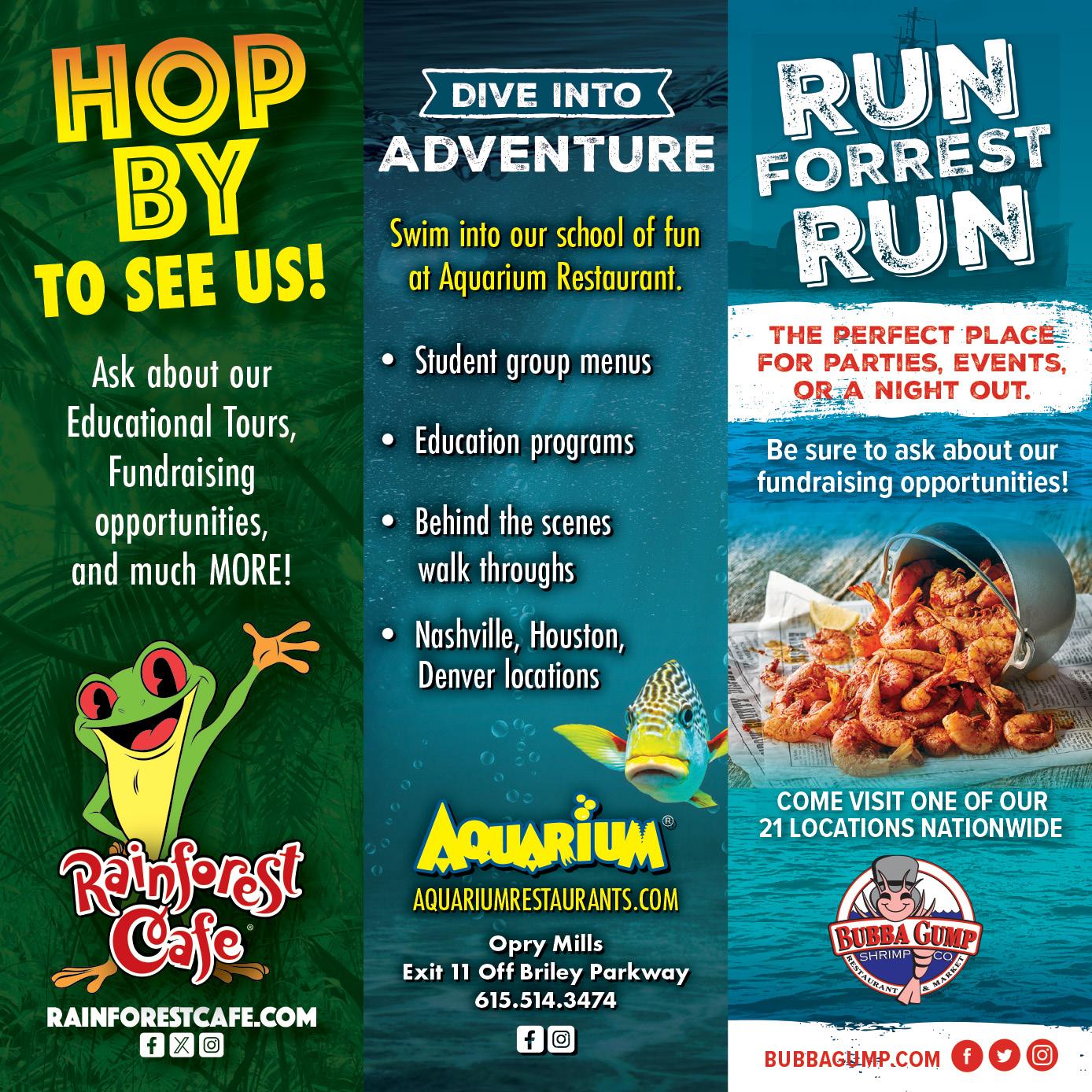




GEORGIA: FROM SKYLINES TO
SHORELINES
FFrom the towering skyline of Atlanta to the moss-draped squares of Savannah and the untamed beauty of its wild coast, Georgia offers something for every kind of student traveler. History, culture, ecology, and entertainment come together in this Southern state, filled to the brim with hands-on learning and unforgettable experiences.

BY JOSH
ATLANTA: ENERGY, INNOVATION, AND ICONIC LANDMARKS
Start your journey in Atlanta , a city that pulses with energy and innovation while honoring its rich history. Whether students are science lovers, art aficionados, aspiring historians, or future athletes, Atlanta offers countless ways to engage.
At the World of Coca-Cola , students dive into the story behind the world’s most iconic beverage brand through immersive exhibits and global tastings—including two new experiences, Coca-Cola Stories and Icons. Just steps away is the Georgia Aquarium , one of the largest in the world, where up-close encounters with beluga whales, manta rays, and sea lions spark excitement and curiosity about ocean conservation.
Sports fans won’t want to miss the College Football Hall of Fame, where interactive exhibits and handson challenges celebrate college football traditions. For a different kind of performance, the Atlanta Symphony Orchestra offers a front-row seat to world-class music and cultural enrichment.
Atlanta’s museums bring history and science to life. The Fernbank Museum of Natural History blends giant dinosaur skeletons with a walk through Georgia’s ecosystems, while the Michael C. Carlos Museum houses ancient artifacts from Egypt, Greece, Rome, and the Americas. Art students will find inspiration at the High Museum of Art, home to a dynamic collection of classic and contemporary works.
For those curious about American politics and 20thcentury history, the Jimmy Carter Presidential Library and Museum provides a deep dive into the life and legacy of the 39th U.S. president. Meanwhile, the Martin Luther King Jr. Center for Non-Violent Social Change and the Martin Luther King Jr. National Historic Site offer powerful insight into the Civil Rights Movement, allowing students to walk in the footsteps of Dr. King himself.
Entertainment abounds at Six Flags Over Georgia , with rides and attractions for every thrill level, and Medieval Times Dinner Theatre, where knights and horses put on a show that brings history to life. At Skyline Park , students can play vintage games, ride the Heege Tower, and take in breathtaking rooftop views, while Illuminarium Atlanta uses state-of-the-art projections to transport groups to other worlds.

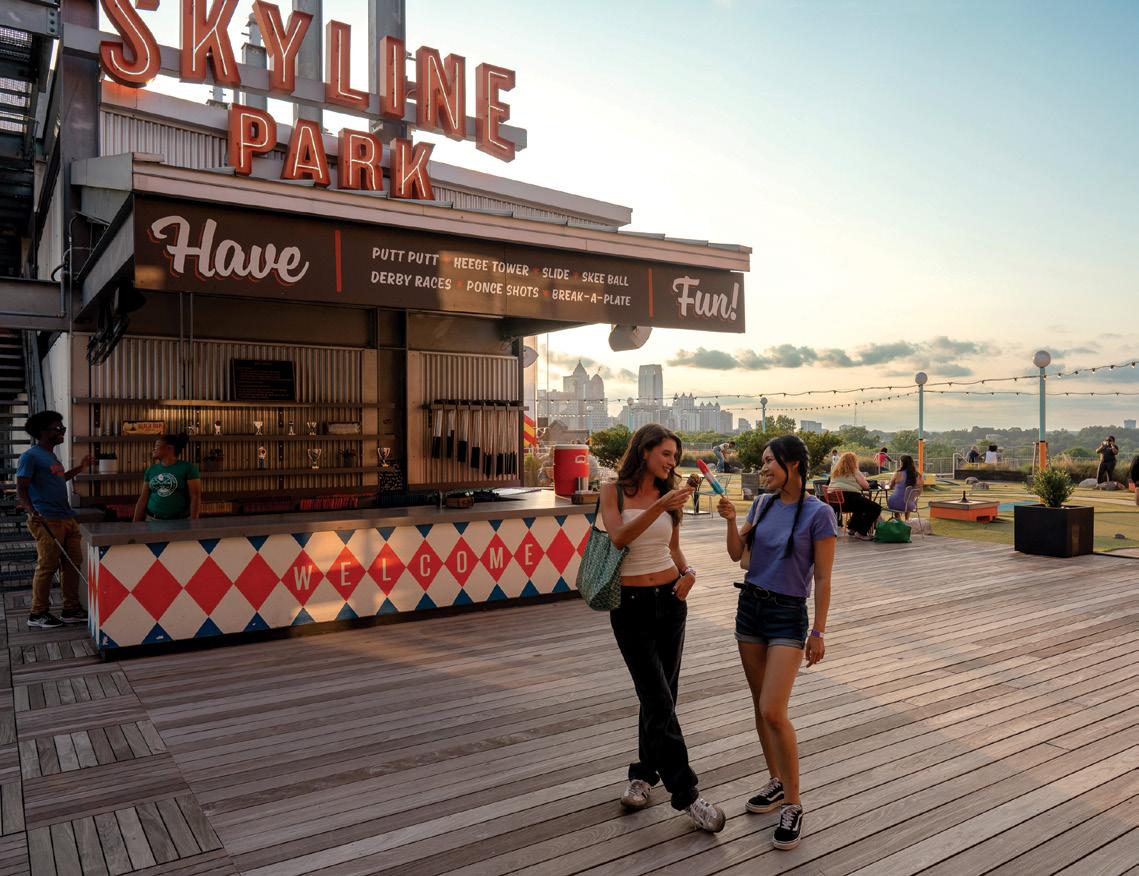


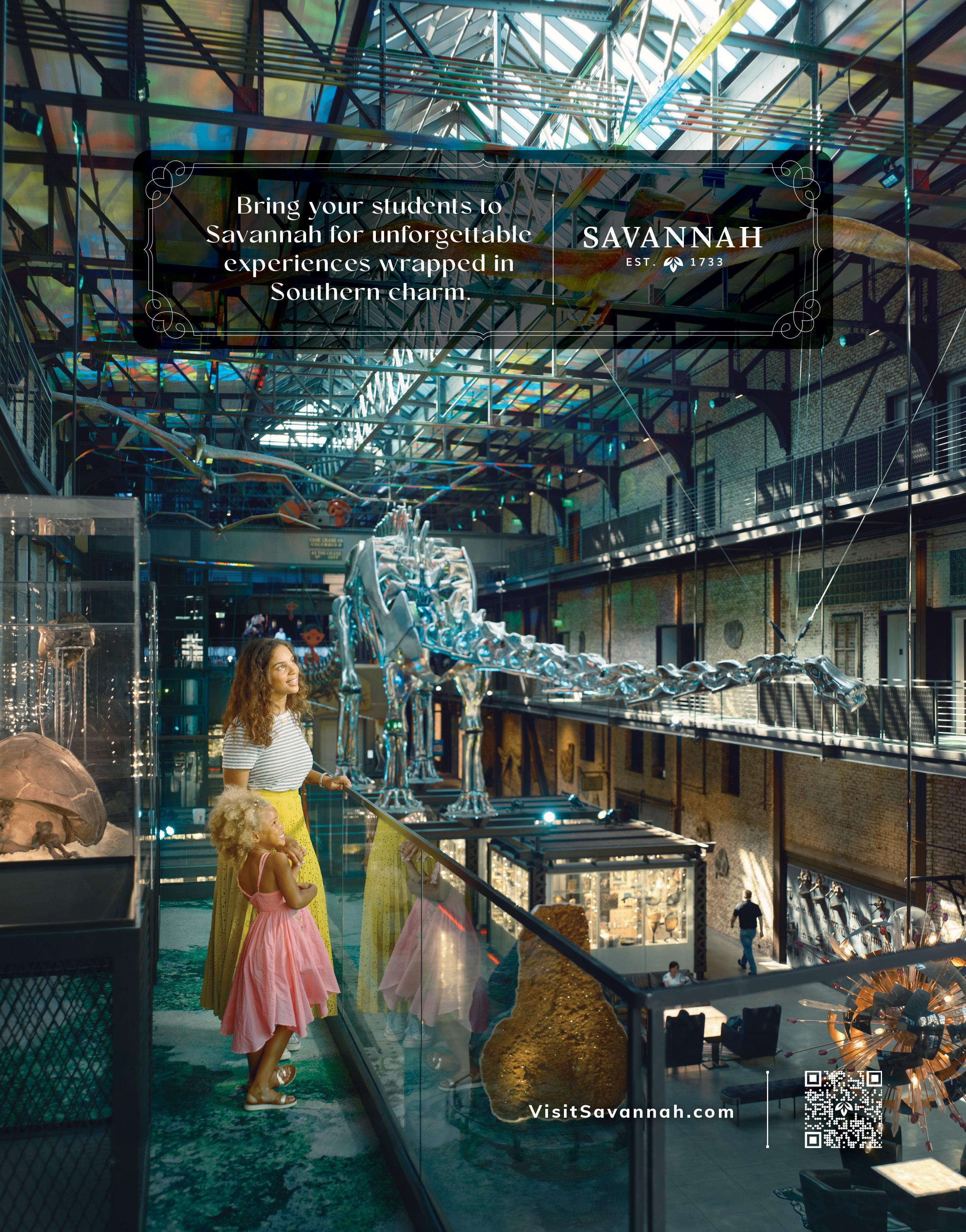



...continued from page 27.
Students interested in horticulture or botany will enjoy a visit to the Atlanta Botanical Garden, where themed gardens, rare orchids, and a treetop walkway provide a peaceful change of pace. And no Atlanta experience is complete without a stop at Truist Park, home of the Atlanta Braves, where student groups can tour the stadium or take in a game.
Atlanta also offers a variety of performance opportunities for student music, theater, or dance groups. Popular venues include Six Flags Over Georgia , Stone Mountain Park , the Junior Theater Festival , and even the Georgia State Capitol or Atlanta VA Medical Center, giving students the chance to share their talents in meaningful and memorable settings.
SAVANNAH: SOUTHERN CHARM AND HISTORIC DISCOVERY
Head southeast to Savannah , the oldest city in Georgia, where cobblestone streets, antebellum architecture, and stories of the past provide an immersive educational backdrop. This coastal city is perfect for students interested in history, performing arts, literature, and marine science. First, students can get their bearings with a walking or trolley tour of the historic district. Stops at the Massie Heritage Center, a 19th-century schoolhouse turned museum, help paint a picture of education in early Georgia. After a boxed lunch in one of the city’s shady squares, it’s time to shop for Savannah specialties—local honey, handmade pralines, and scoops of Leopold’s Ice Cream
While you’re walking, you can point out to students that cobblestones paving Savannah’s popular River Street were originally used as ballast material on ships that sailed into the harbor. Some of those stones hail from Spain, France, and the British Isles.
The afternoon brings a visit to the National Museum of the Mighty Eighth Air Force, where exhibits detail the role of this historic unit in World War II. The day ends with a ghost tour that blends folklore with fact. The Sorrel-Weed House, one of Savannah’s most haunted and historically significant homes, sets a spooky tone for the evening.
For more history, the First African Baptist Church is the first Black church in the country, and dates to 1777. It is also home to one of the oldest Jewish congregations in the United States. Then there’s author Flannery O’Connor’s childhood home, still standing as a tourable museum.
Then, delve deeper into Savannah’s cultural side. The
Georgia State Railroad Museum tells the story of transportation and industrial growth in the South. At the Owens-Thomas House & Slave Quarters, students examine complex narratives of privilege and enslavement. The Juliette Gordon Low Birthplace celebrates the founder of the Girl Scouts and offers leadership inspiration for students of all genders.
At the American Prohibition Museum, students can learn to dance the Charleston and explore the unexpected social shifts of the 1920s. Dinner at The Pirates’ House, a historic tavern full of local legends, leads into a Broadway-style performance at the Savannah Theatre. End the day on the water with a Savannah Riverboat Cruise, where live music and panoramic views offer a fun and festive experience.
Finally, head outside the city into nature’s classroom. Begin with a walk through the Oatland Island Wildlife Center, where trails weave through native habitats and introduce groups to bobcats, birds of prey, and red foxes.
After lunch at The Crab Shack, a local favorite known for its laid-back setting and seafood platters, students dive into marine science with a Tybee Beach Ecology Trip. The day ends with a climb to the top of the Tybee Island Light Station, where sweeping ocean views reward the trek.



BEYOND THE CITIES: STATEWIDE SIGHTS AND NATURAL WONDERS
While Atlanta and Savannah are major hubs, Georgia’s diverse geography offers additional opportunities for student discovery.
In the southeast, St. Simons Island provides a peaceful blend of history, nature, and beach time. Students can visit the lighthouse, bike through moss-lined paths, or explore sites tied to the Gullah-Geechee culture.
To the north, Tallulah Falls offers spectacular hiking and waterfall views within the Tallulah Gorge State Park, perfect for outdoor education and environmental science. For those interested in wildlife conservation, the Georgia Sea Turtle Center on Jekyll Island provides close-up encounters and rehabilitation lessons.
In central Georgia, the town of Madison charms with its preserved antebellum homes and walkable historic district, while Providence Canyon State Park, known as “Georgia’s Little Grand Canyon,” stuns with its colorful geological formations and hiking trails.
History buffs will appreciate the Ocmulgee Mounds National Historical Park , home to Native American earthworks dating back more than 1,000 years. Nearby, the Tubman Museum in Macon explores African American art, history, and culture through dynamic exhibits and performances.
In Plains, Georgia, the Jimmy Carter National Historic Site includes the former president’s boyhood farm, high school, and campaign headquarters—perfect for students studying politics or public service. And for an unforgettable immersion in the natural world, the Okefenokee National Wildlife Refuge offers boat tours, boardwalks, and encounters with alligators and other native species in one of the most biodiverse swamps in the U.S.

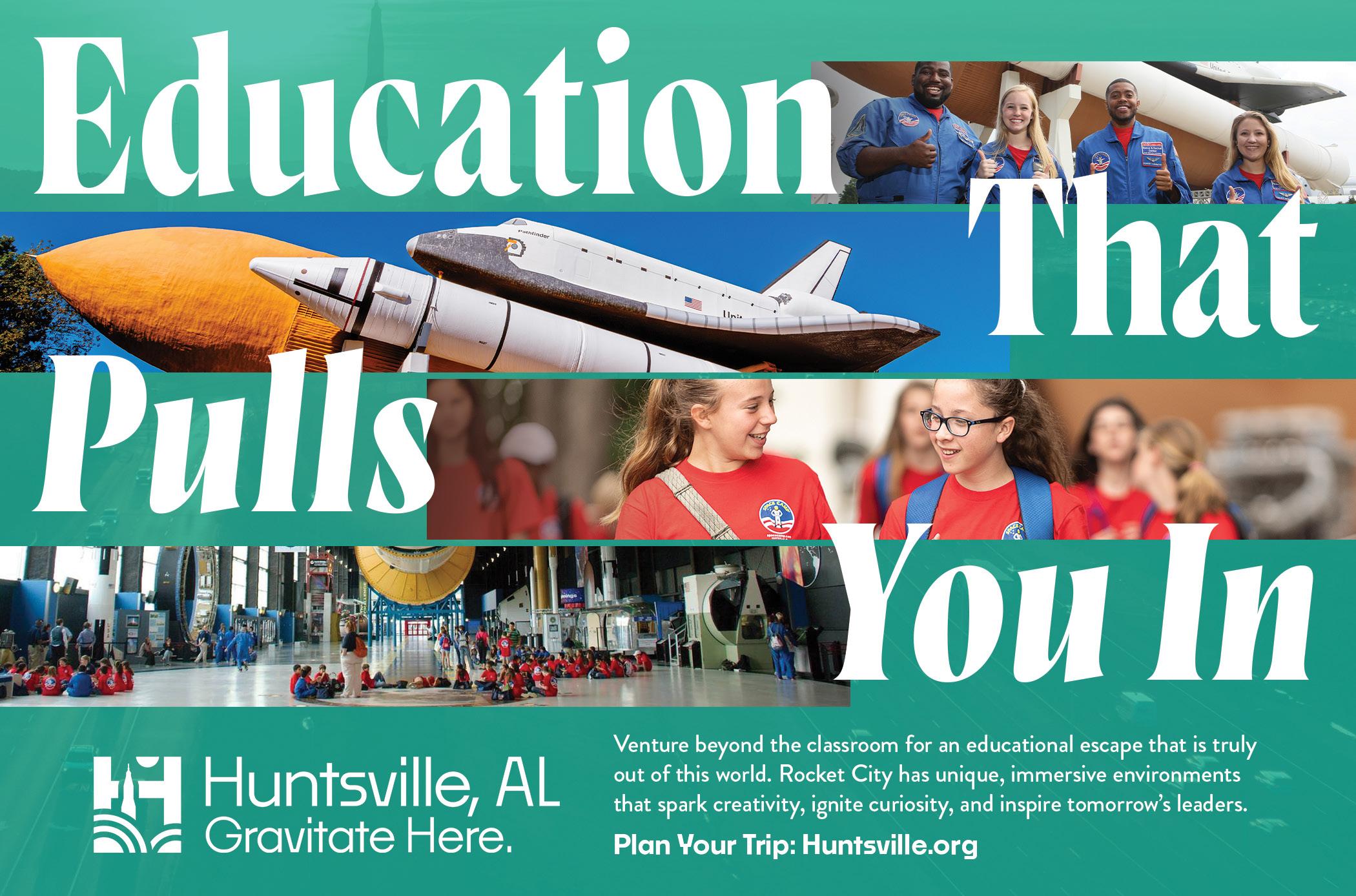



Photo
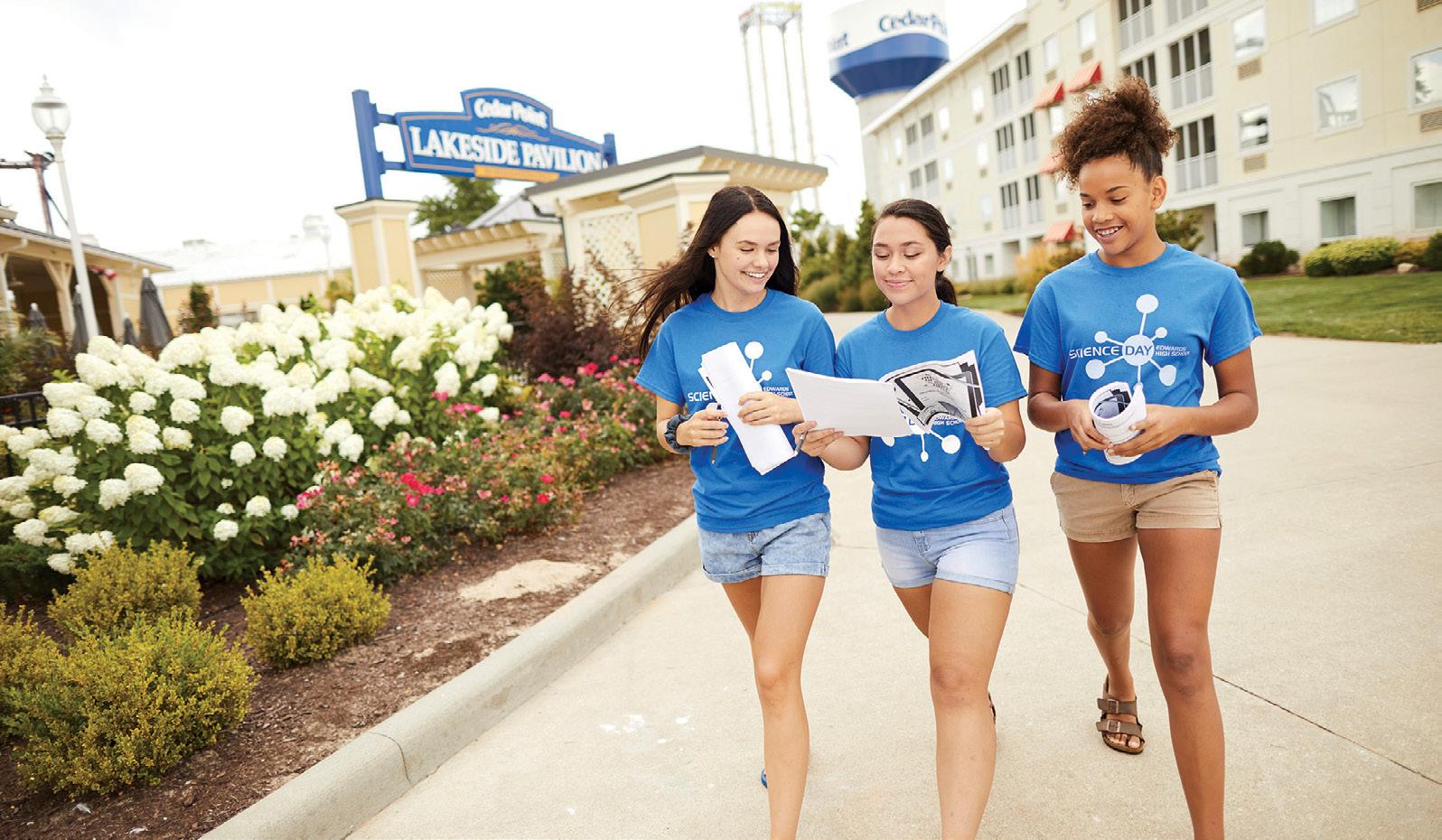
BY ALLISON KAY BANNISTER
TThe Great Lakes are more than just a collection of interconnected freshwater lakes. Yes, they do contain roughly 21% of the world’s surface freshwater, equaling about six quadrillion gallons of water. That’s definitely wow-worthy!
But that’s just the tip of the glacier, so to speak. It’s also an entire region encompassing parts of Canada, Michigan, Illinois, Indiana, Ohio, Wisconsin, Minnesota, Pennsylvania, and New York. And, within this massive expanse, there are lessons in history and people, a variety of ways to explore science and nature, and plenty of opportunities for fun.
Here we’re highlighting some of the top spots stateside for building your student trip itinerary.
Located on Lake Erie, the Shores & Islands area of Ohio has a wide range of sights and activities. A favorite is Put-In Bay on South Bass Island, featuring Lake Erie Islands Nature & Wildlife Center, Lake Erie Islands Historical Museum, and Perry’s Victory & International Peace Memorial—the nation’s third tallest memorial structure. Also on the island is Perry’s Cave Family Fun Center, which boasts an underground limestone cave, a butterfly house, mini golf, gemstone mining, rock climbing, and more.
The Glacial Grooves on Kelleys Island are also noteworthy. Carved 18,000 years ago, they’re an exceptional example of glacial scoring for your budding geologists to study. And, to satisfy your flora and fauna enthusiasts, hop over to Oak Harbor where you’ll find Black Swamp Bird Observatory, Magee Marsh Wildlife Area, and Ottawa National Wildlife Refuge. That’s really just the beginning of what’s available in Shores & Islands!

Traverse City, Michigan has a number of options spanning different educational pathways. The Inland Seas Education Association hosts the hands-on Schoolship, ROV Engineer and Explore, and Watershed Exploration programs in spring and fall, with public sails occurring over the summer months. While in the area, a visit to Sleeping Bear Dunes National Lakeshore is highly recommended, as is taking part in their Junior Ranger program—geared toward kids 13 and under. After completing a series of activities, students earn a badge and certificate.
On the creative side, the National Writers’ Series holds live visitingauthor events throughout the year at Traverse City’s historic City Opera House. They also have a robust Raising Writers program that aims to build the reading and writing skills of young people. Worth looking into, as well, is the summer camp program at Interlochen Center for the Arts, with focus areas such as dance, film and new media, music, theatre, and visual arts.
If you choose Chicago, be prepared to make an extended excursion out of it. There is so much to do! For thrilling and breathtaking views of the city, check out 360 CHICAGO observation deck and step onto TILT—a tilting glass platform, or walk out onto the glass-enclosed Ledge on the 103rd floor of the Skydeck Chicago in the Willis Tower. Then, head to the Museum Campus, which houses three institutions in one complex set on the lakefront: Field Museum, Shedd Aquarium, and Adler Planetarium. If your students are into music, culture, and entertainment, see a show at Lyric Opera of Chicago, The Chicago Theatre, or Broadway
Photos © Shores & Islands Ohio, Traverse City Tourism
in Chicago. Each offers additional opportunities, including tours and Q&A sessions. Also of interest are Peggy Notebaert Nature Museum, Art Institute of Chicago, American Writers Museum, and the Money Museum. And, don’t miss the Zoo Explorers program at the Lincoln Park Zoo.
Toledo, known as “Glass City” is home to Toledo Museum of Art, which has a reputation as one of the best attractions in Ohio. Be sure to visit 74,000-square-foot The Glass Pavilion while there. On the STEM side, there’s Imagination Station with its array of interactive exhibits to stimulate visitors of all ages. Since you’re in the eponymous region, a stop at National Museum of the Great Lakes should be on your list as well. And, continue your history lesson at Fort Meigs: Ohio’s War of 1812 Battlefield.
There’s ample adventure to be had in Toledo, too! In addition to Toledo Zoo & Aquarium, try one of their many amusements. Let loose at Urban Air Adventure, Sky Zone Trampoline Park, Q-Zar Laser Tag, or Reset Arcade. Or, crack clues while building teamwork at TRAPPED Toledo escape room.
Let’s not forget that Pennsylvania is in the region, too; the aptly named city of Erie gives that away! At Erie Maritime Museum, your students can get on board the Lettie G. Howard, a Fredonia-style schooner, and see a sailing demonstration or jump right into tying knots, raising and lowering the mast, or loading a cannon. Hagen History Center is another must, with its “The Story of Us” exhibit, which focuses on Erie’s early immigrant families and their contribution to the community’s industrial growth.

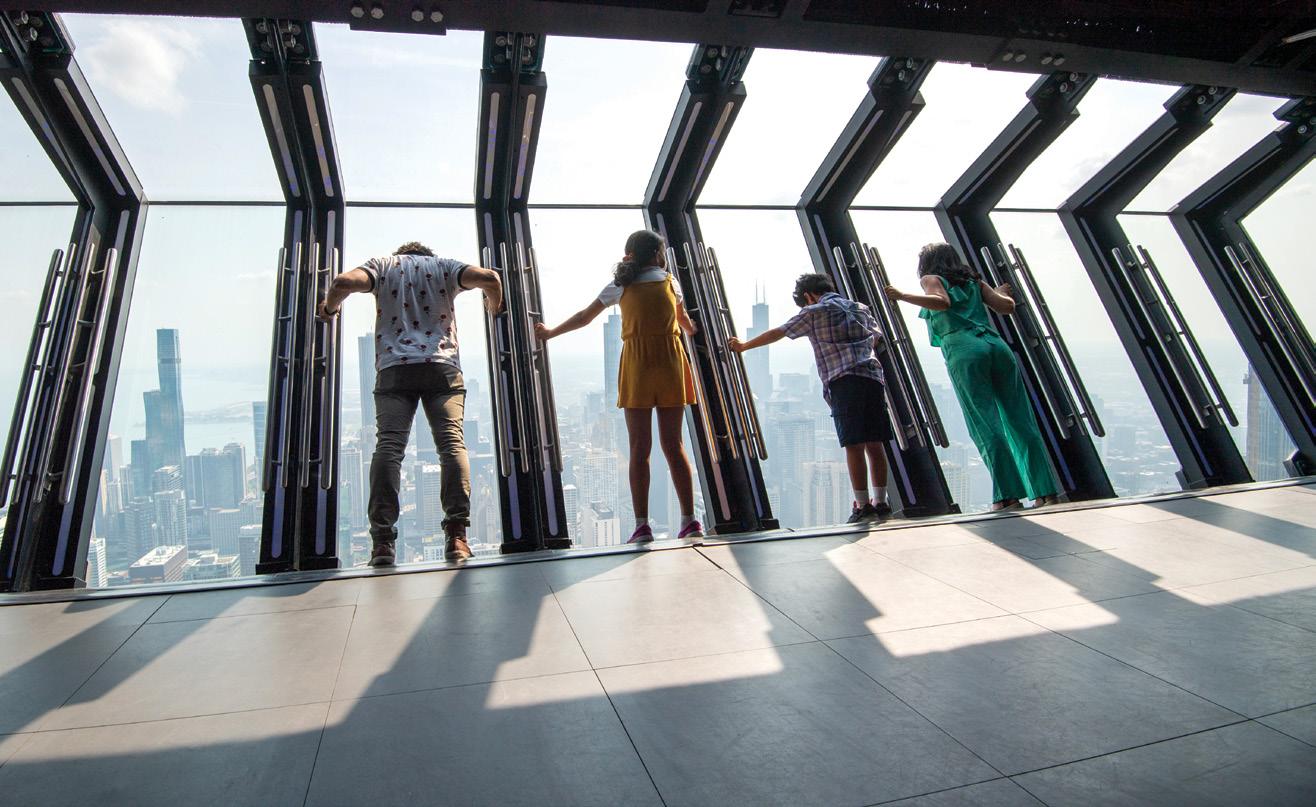
Asbury Woods provides you a view into Pennsylvania’s environmental world, with hundreds of acres of trails, wetlands, waterways, and forests, plus Brown’s Farm Barn and the Andrew J. Conner Nature Center. There’s also Port Farms, a working farm with educational programs and tons of activities. They have two seasons: Summer Days and Fall Harvest, so plan to visit between August and November, accordingly.
Milwaukee, Wisconsin flanks the region on the west, and, like other destinations, is overflowing with things to do and see. Milwaukee Art Museum, Milwaukee Public Museum, Mitchell Park Horticultural Conservatory, and Milwaukee County Zoo each offer their own draw, and a trip to all of them provides your group with a well-rounded experience.
Appealing to the younger crowd, there’s Discovery World. Set on Lake Michigan, it’s considered the top science museum in Wisconsin. And, accommodating all ages and larger group sizes, check out Game Show Battle Room, where you and your students can face-off against one another playing a variety of game-show style challenges. Be sure to consult Milwaukee Mural Map, too, for a directory of the many inspiring outdoor murals in and around the city.
Wherever you decide to take your students, consider adding a Six Flags Entertainment offering to your schedule. If you’re in Shores & Islands you’ll want to hit Cedar Point either way, but they also have Physics, Science & Math Days on select dates in May, and Performance in the Park for marching bands and other music groups, typically available any park operating day with advanced arrangements. Or, while in Illinois, make a stop at Great America in Gurnee, which also has Math and Science Days roughly April through June and a special Grad Nite, with specific dates in late April and early May. Dates change yearly, so check their sites for exact timing and booking information.


Photos © Abel Arciniega, Asbury Woods, Visit Milwaukee






For young people, travel is an education in itself. It helps them build self-esteem, independence, tolerance and cultural understanding, while breaking down barriers to a child’s personal, educational and social development. Patterns and habits embraced when traveling at an early age are known to influence future decisions. The benefits of travel go beyond education. Increasingly, governments and businesses are recognizing the positive effects of youth travel as a powerful life experience that promotes economic development, job fulfillment and cultural understanding. Learn more at teachtravel.org



















in Portugal
BY JOSH VEAL
FFor student travelers seeking a dynamic blend of history, hands-on art, sun-soaked coastline, and soulful music, Portugal is ideal.
Stretching along the western edge of the Iberian Peninsula, this small but vibrant country delivers a hugely diverse range of experiences—from the winding alleys of medieval neighborhoods to golden beaches and grand palaces.
A guided journey through Portugal offers young explorers a chance to learn, create, and connect with one of Europe’s oldest cultures.
LISBON:
The Historic Heartbeat of Portugal
The adventure begins in Lisbon , Portugal’s sundrenched capital and the country’s largest city, where cobblestone streets twist through ancient neighborhoods. Students will start by exploring the Alfama district, the city’s oldest quarter, with whitewashed buildings clinging to steep hills and the sounds of Fado drifting through narrow lanes. A walking tour reveals how Lisbon’s history—from Phoenician roots to Moorish architecture— lives on in its daily rhythms.
One of the highlights is a visit to Castelo de São Jorge, perched high above the city. Once a royal residence and military stronghold, the castle offers panoramic views and a tangible connection to Lisbon’s centuries-old past. Students can also tour the Jerónimos Monastery, a masterpiece of Manueline architecture, and stop for photos at the Tower of Belém and the Monument to the Discoveries, two iconic landmarks commemorating Portugal’s Age of Exploration.
No trip to Lisbon is complete without tasting the country’s beloved pastéis de nata, and students will get to enjoy them at Pastéis de Belém , where this egg custard tart originated. For a hands-on cultural experience, they’ll participate in an azulejo tile-making workshop, crafting their own version of the signature blue-and-white ceramic art that adorns buildings across the country.
For performance groups, Lisbon offers the chance to share their talents at venues such as the Lisbon Coliseum , the Theatre of the Spanish Institute, or St. Dominic’s International School. An optional evening excursion to a traditional fado performance provides a haunting, heartfelt window into Portuguese soul, where songs of longing and nostalgia tell stories that resonate across generations.


Day Trips to SINTRA AND CASCAIS
A day trip from Lisbon whisks students to the fairytale town of Sintra , a UNESCO World Heritage Site famed for its romantic palaces and misty mountain setting. Here, they’ll visit the Palácio Nacional de Sintra , with its dramatic twin chimneys and blend of Gothic, Manueline, and Moorish styles. After exploring Sintra, the journey continues to Cascais, a former fishing village turned upscale coastal retreat. With free time to wander the beaches, cafes, and charming streets—or explore the nearby Citadel of Cascais—students can soak up the relaxed Atlantic vibes.


PORTO:
The Charms of the North
From there, students board a high-speed train to Porto, a city that rivals the capital in beauty and character. Known for its colorful riverside houses, port wine cellars, and ornate Baroque churches, Porto offers a new layer of Portuguese culture. A walking tour of the Ribeira district, part of the UNESCOdesignated Historic Centre, reveals the city’s medieval roots and modern vibrancy.
The stunning Clérigos Church beckons students to climb its 75-meter-high bell tower for breathtaking city views, while a visit to Livraria Lello—a jewellike bookstore rumored to have inspired elements of Harry Potter—wows visitors with its stained glass, carved woodwork, and dramatic staircase.
Students can also take a scenic Douro River cruise, gliding past terraced vineyards and stately bridges. At sunset, they’ll gather near the Dom Luís I Bridge for one of the most photogenic moments of the trip. Music and performance students may even have the opportunity to perform at the Casa da Música or University of Porto, sharing their craft in one of Portugal’s cultural hubs.
COIMBRA, FÁTIMA, and the Spirit of Tradition
Continuing south, the group will stop in Coimbra , home to one of Europe’s oldest universities. Here, students tour the Coimbra University Library, a baroque masterpiece, and visit the Santa Cruz Monastery, a significant religious and architectural site. The town’s Old Quarter is a labyrinth of stone alleys, academic history, and timeless charm.
In Fátima , a site of major religious pilgrimage, students will learn about the reported Marian apparitions that have drawn millions of visitors. A visit to the Batalha Monastery, another UNESCO site, showcases Gothic grandeur at its most impressive.
ÉVORA: Echoes of Ancient Civilizations
The journey concludes in Évora , a museum-like city enclosed by ancient walls. A guided walking tour reveals a tapestry of historical layers—from Moorish arches and Roman ruins to Renaissance squares and tiled courtyards. Students will see the Roman Temple, stroll past 16th- and 17th-century mansions, and pause in Praça do Giraldo, the city’s main square.
A visit to the Chapel of Bones leaves a lasting impression. This macabre site, where walls are lined with thousands of human bones, prompts reflection on history, mortality, and the fragility of life—deep topics for student travelers, but ones that enrich their understanding of Portugal’s complex heritage.


Photos © Adobe Stock / (Bottom Left) © Kelsea Rounds




TTravel guides and tour operators juggle itineraries and deal with contingencies, but the past year has been an endless roller coaster filled with challenges and uncertainty.
Civil unrest around the world; higher prices for hotels, food, and beverages; staff shortages, business closings; increased prices due to tariffs and other unpredictable situations make planning student travel a challenge.
There are often roadblocks, and educators and administrators sometimes choose to postpone trips. Instead of depriving students of these travel opportunities and experiences, they should do careful planning, with safety as the main factor.
Educators can focus on these five
BY JULIE BECK
TRAVELING DURING TIMES OF UNCERTAINTY
key aspects (1) stay informed (2) plan and prepare and (3) practice safety measures (4) purchase travel insurance (5) maintain mental agility and flexibility to determine if travel is do-able during times of uncertainty.
Stay informed whether traveling around the USA or to a foreign country. If traveling overseas, be sure to consult the U.S. Department of State for travel advisories and country-specific information.
Once the itinerary is confirmed, the teacher should encourage each traveler to set up a free account with Smart Traveler Enrollment Program (STEP). This allows travelers to identify which country they will be in so the U.S. Department of State is aware of the location of US citizens and can contact
them via email if necessary.
Two summers ago, I explored Europe and planned to visit Slovenia. Unfortunately, Slovenia had major flooding and travel to Slovenia was no longer an option. Because I had a STEP account and had listed my itinerary, I learned about the flooding and unsafe travel when I received an email from the U.S. Dept of State. As a result, I changed my travels to a new destination.
Plan and Prepare for your journey. Use a SYTA or wellrespected travel agency to organize your trip. These agencies have the resources to adapt as needed. Years ago, I led a group of college students to Greece. While there, demonstrations occurred, and it
DO TO THE UNCERTAINTY OF TRAVEL NOW, [TRAVEL INSURANCE] is just as important to me as my itinerary, flight schedule and accommodation.
impacted our trip. Gate 1 Travel adjusted our schedule, altered our transportation, changed our accommodation, and reassured us that we were safe. It was comforting to know that we had a travel agency who genuinely cared about their clients and had Plan B in place for such disruptions.
Make sure you are familiar with the laws and potential risks associated with your designation. Before you leave for your journey, send a digital copy of your itinerary and important documents (passport, visa, insurance, emergency contacts) to yourself.
Practice Safety Measures while traveling. Students and educators need to be aware of their surroundings, not overshare information with strangers, and pay close attention to your belongings. Years ago, I was visiting Spain and haphazardly placed my day pack on the ground beside me. I was hot & tired and just wanted to rest for a bit. A fellow tourist informed me people not paying attention often had their belongings stolen in this touristy location, and he recommended I place the strap of the backpack around my leg.
Ever since then, I have become more aware of my belongings and my surroundings. I pay attention to where I am, the nearest transportation system, and others around me. I recommend travelers use crossbody bags with RFID pockets, maintain a list of emergency phone numbers and keep phones charged.
Purchasing Travel Insurance is a priority now. There are numerous companies like Allianz, AAA, Safety Wing, World Nomads, and others that offer travel insurance, but make sure they provide what you need.
Key provisions you should look for in the policy should include trip cancellation (including Cancel for Any Reason), lost or damaged baggage, medical emergencies (you or someone at home) and potential disruptions related to unforeseen events. Travel insurance prices can vary based on age of participants, length of trip, cost of trip, high-risk activities and what is covered in the comprehensive travel insurance.
I never used to purchase travel insurance; it was just another expense. Due to the uncertainty of travel now, it’s just as important to me as my itinerary, flight schedule and accommodation.
Finally, Maintain Mental Agility and Flexibility while traveling. Things will go wrong, but one must remain calm, adapt, and adjust. It is important to rely on your travel company, who often has local guides who speak the language and are familiar with the location, to assist. Sometimes, the new plan turns out better than the old plan.
My friend Patti and I took a fourday Nile River cruise in Egypt. Due to an unforeseen incident, all river boats had to end at Aswan, and passengers were not allowed to sleep on the boat the last night. At first, we were upset, but when we learned that our tour operator had booked us a room at a 5-Star hotel on the Nile River, our attitudes changed. When I walked into the hotel and saw the marble floors, I no longer cared about sleeping on the boat.
Those leading others on an educational trip must be prepared for things to go awry. Keep a cheerful outlook, solve problems, remain calm and be flexible. Most importantly, keep a sense of humor.


BY JOSH VEAL


BUILDING CONNECTIONS AROUND THE WORLD
FFrom Peru to Japan, Justin TrinhHalperin takes his students across the globe.
The middle school math and science teacher at Bullis Charter School in Los Altos, California was a top finalist in 2025’s Traveling Teacher of the Year, thanks to years of efforts showing students the world in a highly intentional way. STEM, environmental science, history and language arts all play a large part in the trips he organizes with Education First—before, during and after.
HOW DID THIS JAPAN TRIP COME ABOUT?
I was looking for someplace else
I could tie to the middle school curriculum, with the Middle Ages. So we could go to Kyoto, Namura, we could do everything that the kids were learning in their history books, and bring that to life. But then also, because we’re in Silicon Valley, tie in the tech piece. So, we added in teamLab and STEM stuff in Tokyo. And then last year, I added in the wind caves and ice caves of Fuji, because I think it’s important to experience nature. The trip is getting longer, but the school district is seeing the value.
We also have a teacher at our school that lived in Osaka, so we do some special things while we’re there. We take a calligraphy class
from one of his childhood friends, go to some restaurants off the beaten path for Okinawan food, take a taiko drumming lesson, stuff like that.
WHAT BROUGHT ABOUT THE PERU TRIP?
Study of the Incas ties into the middle school curriculum. So, it was an easy sell there. And then I added an extension, a 3-day trip to the Amazon basin. My undergrad is Ecological Biology and Environmental Science, so I’m very passionate about getting kids out into the environment. The only way they’re going to save it is if they interact with it.
And this is off-grid, three hours
up a river. There’s going to be 50 of them, and we’re staying at an Eco Lodge that gets three or four hours of electricity each day. So, I think it’ll be very eye-opening for some of these Silicon Valley kids.
HOW DO YOU PREPARE STUDENTS FOR A TRIP OF THIS MAGNITUDE?
I started a weekly Japanese cultural language club, and a good majority of the students that go on the trip join the club, and it’s very successful. Then, I have mandatory monthly meetings starting about six months out. We discuss the trip and talk about behaviors, what to expect, and start learning phrases. I create Google classrooms, giving them assignments as well, Duolingo challenges and stuff like that, the cultural nuances of what’s acceptable conversation in these countries, and what’s not. Also, while on tour each night, I send out what to expect and a history of where we’re visiting. They need to read through that, and there’ll be a quiz in the morning on the bus. And then, of course, I have the support of language teachers, art teachers, history teachers at my school.
WHAT’S ONE BIG HIGHLIGHT FROM YOUR RECENT JAPAN TRIP?
We met with Clark International School when we were there, and we had a picnic, and just seeing our kids in small groups sitting in circles and interacting with the kids, doing TikTok dances and playing games—even though my kids were not fluent in Japanese, and the students from Clark were not fluent in English, they were communicating and laughing and having a great time. That gave me goosebumps, just to have that kind of cultural exchange.

Alabama Tourism Department 3 www.alabama.travel
Bob Rogers Travel C4 www.bobrogerstravel.com
Branson Convention & Visitors Bureau 5 www.explorebranson.com
Broadway in Chicago 37 www.broadwayinchicago.com
Chick-fil-A College Football Hall of Fame 28 www.cfbhall.com
Colonial Williamsburg Foundation 20 www.colonialwilliamsburg.com
Disney Theatrical 15 www.disneytheatricalsales.com
Earl Enterprises 13 www.earlenterprise.com
Empire State Building Observatory 4 www.esbnyc.com
ESCOT Bus Lines 43 www.escotbuslines.com
Explore St. Louis 45 www.explorestlouis.com
Graceland/ Elvis Presley Enterprises 19 www.graceland.com
Group Sales Box Office at Broadway.com C2 www.broadway.com/groups
Huntsville/ Madison County CVB 32 www.educationalescapes.org
Jamestown-Yorktown Foundation 13 www.jyfmuseums.org
Landry’s 23 www.landrysinc.com
Main Event 39 www.mainevent.com
Marine Corps Heritage Foundation 14 www.usmcmuseum.com/education.html
MTD Research 43 www.mtdresearch.com
New England Aquarium 38 www.neaq.org
New York City Ballet 23 www.nycballet.com
New York Philharmonic 10 www.nyphil.org
New York Power Authority C3 www.nypa.gov
PhotoVision, Inc. 14 www.grouptravelvideos.com
Pigeon Forge Department of Tourism 43 www.pigeonforgetours.com
Revolutionary Valley 9 www.merrimackvalley.org
Richmond Region Tourism 33 www.visitrichmondva.com
Ron Jon Surf Shop of Florida, Inc. 32 www.ronjonsurfshop.com
Salem Witch Museum 8 www.salemwitchmuseum.com
Sevierville Convention & Visitors Bureau / Chamber of Commerce 11 www.visitsevierville.com
Shear Madness 19 www.shearmadness.com
Shores & Islands Ohio 37 www.shoresandislands.com

SLOWING DOWN & SOAKING UP LIFE
IIn the quiet of dawn, as soft light fell across the swaying coconut palms, I realized it was not just another destination, but an open invitation to see life through a different lens. What truly moved me wasn’t the postcardperfect landscapes, but the sense of community and the gentle rhythm of daily life.
Kerala, nestled along India’s southwestern coast and often called “God’s Own Country”, is known for its natural beauty and rich cultural heritage. The moment I arrived there with my family, I felt a deep sense of serenity wash over me, as the lush greenery, peaceful backwaters, and warm smiles of the people welcomed us.
As I explored Kerala, I saw history living alongside modern life, from the Portuguese-era buildings in Fort Kochi to Chinese fishing nets lining the shores. The layers of Arabian, Dutch, and British influence could be tasted in the food and felt in the stories shared by locals. It was the first time I had truly witnessed a life not built around speed and schedules, but around presence and peace.
Zipping through Kerala’s bustling streets in an auto rickshaw offered me a vibrant glimpse of everyday life.
In a rural village, locals invited us into their homes with sincere curiosity, and our guide helped bridge the language barrier. At dinner with one family, one of them proudly said, “Here, we believe food is best enjoyed together.” I nodded, savoring the rich flavors of traditional Kerala cuisine, and realized how much I’d been missing in my own hurried meals. That simple evening taught me more about connection than any classroom ever could.
People greeted each other with kindness, and respect flowed between generations. From the lively streets of Kochi to Alleppey’s serene backwaters, I saw a life tied closely to the land and water. While drifting on a houseboat, I spoke with a local fisherman who said, “The water is our livelihood. It feeds us, moves us, and gives us what we need.” His words echoed long after our conversation ended.
Back home, I was used to convenience and took nature for granted. But here, I saw how nature could be both a provider and a teacher. Watching him cast his net, I realized the beauty of simplicity and coexistence with nature. In that

BY AJRIN NAWAZ
quiet moment, I felt a deep respect for nature and those living with it. It opened my eyes to the simple things I often took for granted, like water, food, and human connection.
The people I met found happiness in small moments, like cooking together, sharing stories, and embracing nature. Now, I try to carry that same awareness into my life. I eat slower. I put my phone down at dinner. I listen more.
Today, even halfway around the globe, I can still feel Kerala’s steady pulse guiding me toward gratitude. This trip reshaped both my emotions and my perspective, teaching me lessons no textbook ever could. It showed me that travel has the power to transform us in unexpected ways. The most lasting souvenirs weren’t the ones I brought back in my suitcase, but the lessons that continue to travel with me.

The water is our livelihood. IT FEEDS US, MOVES US, AND GIVES US WHAT WE NEED.
Nawaz, 16, is a junior at Rock Ridge High School in Ashburn, VA
Photo © Ajrin Nawaz

